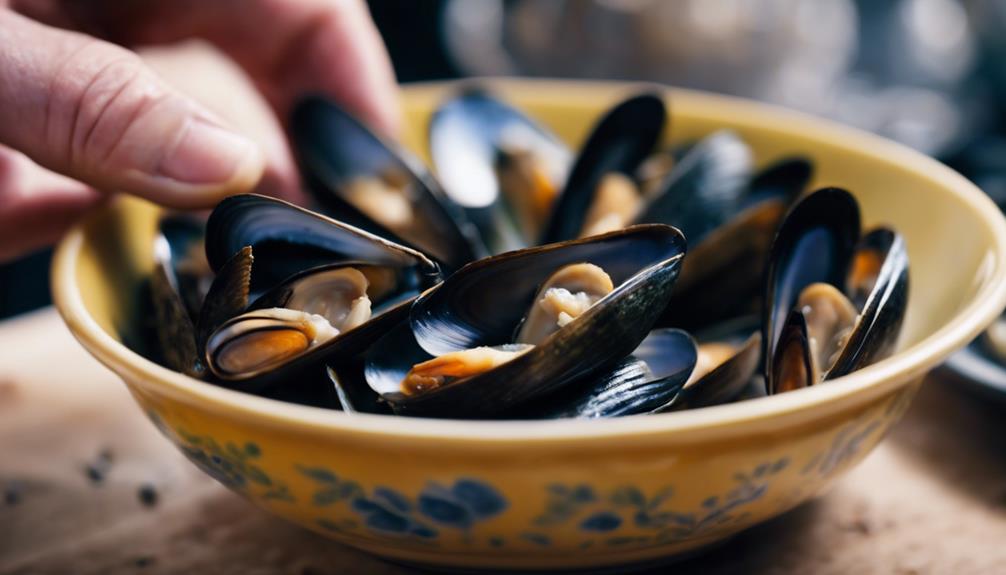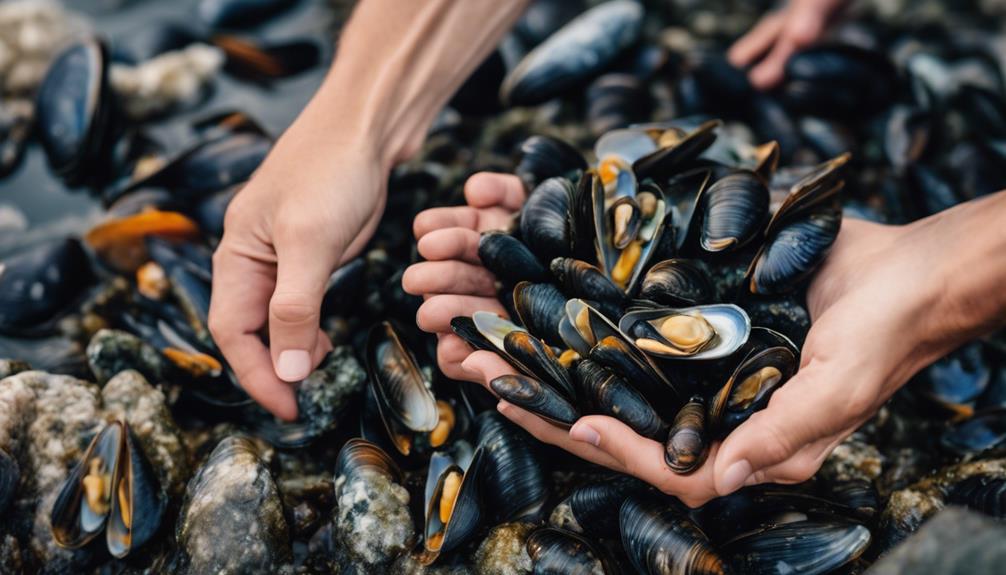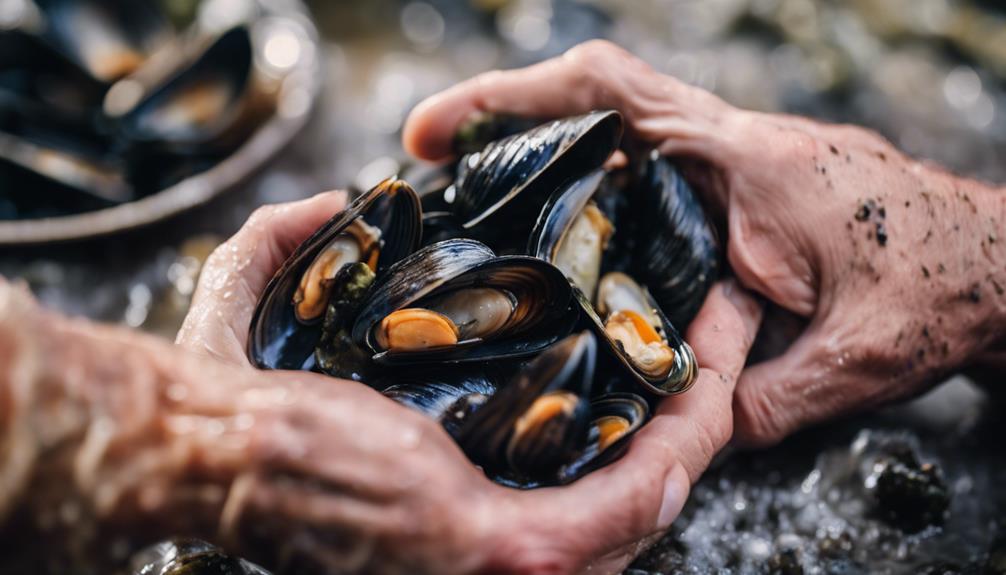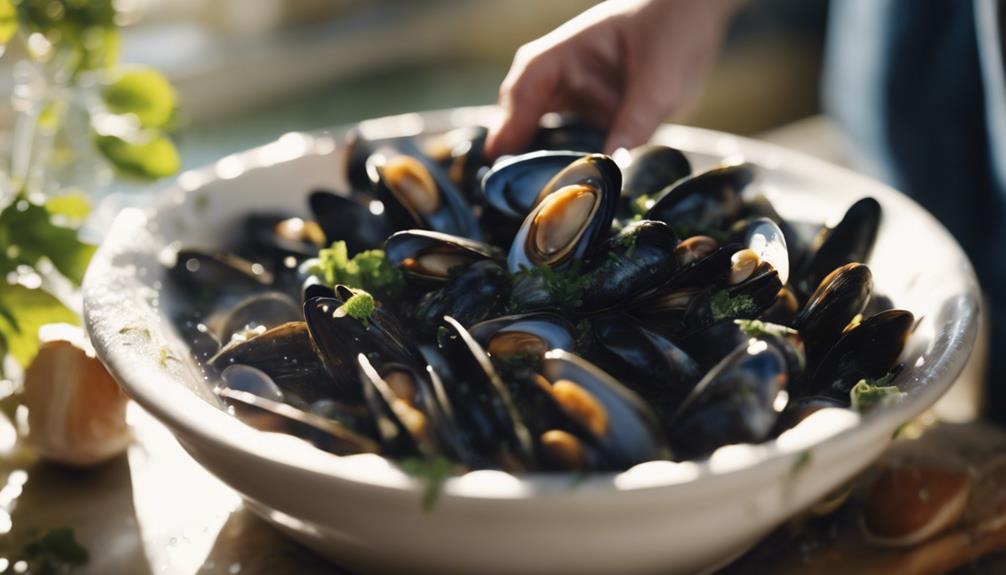To ensure perfectly cleaned foraged mussels, begin by immersing them in cold water for 30 minutes to get rid of any grit and debris. Next, grab the beard and pull it towards the shell’s hinge, carefully detach them from rocks, and rub the shells together to remove any barnacles for a smoother cooking experience. Remember to inspect, debeard, and scrub the mussels before cooking to ensure a delicious and safe meal. This thorough process guarantees a delightful culinary adventure. Discover additional culinary tips to elevate your seafood dishes and relish in the harmonious flavors that await you.
Key Takeaways
- Soak foraged mussels in cold water to remove grit and debris.
- Carefully remove the beard by pulling towards the shell's hinge.
- Gently detach mussels from rocks and rub shells to eliminate barnacles.
- Inspect, debeard, and scrub mussels thoroughly before cooking.
- Ensure mussels are safe by testing for toxins and following local regulations.
Soaking Mussels in Water
To effectively clean foraged mussels, begin by soaking them in cold water for approximately 30 minutes to purge sand and debris. Soaking mussels in water is an essential step in preparing these delectable shellfish for cooking. Not only does this process help rid the mussels of any unwanted grit, but it also aids in plumping them up, ensuring a more succulent final dish.
The recommended 30-minute soak in cold water not only maintains the freshness of the mussels but also plays a significant role in enhancing their flavor. As the mussels sit in the water, they naturally expel any sand or debris they may have accumulated, resulting in a cleaner and more enjoyable dining experience.
Removing the Beard

Start by firmly grasping the beard of the mussel between your thumb and forefinger to remove it. The beard, a fibrous strand that helps the mussel attach to rocks, can be easily taken off by pulling it towards the shell's hinge. To make the process smoother, consider soaking the mussels in salt water before tackling the beards.
Here are some tips to guide you through this task:
- Gently but firmly tug the beard to avoid breaking it.
- Keep a steady hand to prevent the beard from slipping out of your grasp.
- Be patient; some beards may be more stubborn to remove than others.
- Enjoy the satisfaction of cleanly removing the beard, revealing the mussel's pristine shell.
- Remember that a clean mussel without its beard is one step closer to a delicious meal.
Detaching From Rocks

To detach mussels from rocks, gently pull on the beard protruding from the shell. This fibrous thread is how mussels anchor themselves to surfaces like rocks.
Rock Detachment Tools
Using a mussel knife or a sharp tool gently insert between the mussel's shell and the rock to detach it effectively. Rock detachment tools are essential for safely harvesting mussels.
Here are five emotional aspects to keep in mind while using these tools:
- Respect: Treat the mussels and their environment with care.
- Precision: Guarantee accurate placement of the tool to avoid damaging the delicate shells.
- Connection: Feel the satisfying moment when the mussel releases from the rock.
- Appreciation: Recognize the effort required to detach mussels without causing harm.
- Responsibility: Take pride in using the correct techniques to safeguard both the mussels and the ecosystem.
Gentle Twisting Technique
Effortlessly detach mussels from rocks by employing the gentle twisting technique to break the byssal threads.
When foraging for mussels, it's important to delicately twist them to separate them from their rocky homes. Byssal threads, the protein fibers mussels use to cling to surfaces, require a gentle touch to release the shellfish unharmed.
To master this technique, gently twist the mussels with a subtle back-and-forth motion to detach them smoothly. This method guarantees the mussels are freed from the rocks without causing damage to their shells or the mussel itself.
By utilizing the twisting technique, you can easily remove mussels from their rocky perches, preparing them for the subsequent cleaning and cooking processes.
Safety Precautions Foragers
Guarantee your safety while detaching mussels from rocks by following these essential precautions:
- Always face the ocean: Guarantee you have a clear view of the water to react quickly to any changes in the environment.
- Beware of large swells: Avoid turning your back on the ocean, especially during big waves, to prevent being caught off guard.
- Harvest a manageable amount: Limit your collection to around 30 clean mussels to maintain control and prevent overwhelming yourself.
- Check environmental conditions: Choose a calm water area for easier harvesting and to reduce risks associated with rough seas.
- Stay aware of your surroundings: Keep an eye out for slippery rocks, sharp edges, and other hazards that could lead to accidents.
Rubbing to Eliminate Barnacles

For effective barnacle removal from foraged mussels, vigorously rub the shells together to dislodge any attached small barnacles. By creating friction between the shells, you can effectively remove these unwanted hitchhikers. The rubbing motion helps loosen the barnacles, making them easier to be detached. This step is important in guaranteeing a smooth cooking process and enhancing the overall presentation of your mussels.
When rubbing the mussels, pay special attention to areas where small barnacles are clustered. These spots tend to harbor more barnacles, so focusing on them will ensure a thorough cleaning process.
Enhancing Flavor With Cleaning

Enhancing the flavor of your foraged mussels starts with thorough cleaning to remove sand and barnacles, ensuring a delightful culinary experience.
- Rinse with Care: Gently rinse mussels under cold water to maintain their delicate flavor profile.
- Inspect Closely: Take the time to inspect each mussel, ensuring they're free from any visible debris.
- Debeard with Precision: Properly debeard mussels to eliminate any unwanted textures while cooking.
- Scrub Thoughtfully: Use a brush to scrub mussels, guaranteeing a clean and appetizing final dish.
- Enjoy the Process: Embrace the cleaning process as part of the journey to savoring delicious foraged mussels.
Ensuring Safety and Quality

Prioritize safety and quality when foraging mussels by following essential guidelines and precautions. Before heading out, check for red tide warnings and consult local authorities for shellfish safety guidelines to avoid harmful toxins.
To make certain the mussels you gather are safe to consume, use caution when testing for toxins by rubbing them on your lips and watching for symptoms of paralytic shellfish poisoning.
It's imperative to harvest mussels responsibly by handpicking them to minimize damage to mussel beds and reduce environmental impact. Opt for harvesting in clear, calm water conditions and target mussels from high intertidal zones for easier and safer collection.
Freeing Mussels From Debris

To guarantee mussels are free from debris effectively, start by scrubbing them to remove barnacles and seaweed, then rinse under cold water for a thorough clean.
Next, focus on removing sand and grit by soaking the mussels in cold water with a touch of flour to help expel any unwanted particles.
This process secures that your mussels are clean and ready to enhance the flavors of your dish, providing a delightful dining experience.
Removing Sand and Grit
Start by soaking the wild mussels in cold water for 30 minutes to allow them to filter out sand and grit. This step is important to make sure your mussels are free from any unwanted debris that may affect the taste and texture of your dish.
Here are a few tips to help you effectively remove sand and grit from your foraged mussels:
- Be Patient: Letting the mussels sit in water gives them time to expel any sand or grit they may have inside.
- Handle with Care: Avoid agitating the water too much, as this can cause the mussels to re-ingest the sand they've already filtered out.
- Stay Observant: Keep an eye out for any mussels that aren't tightly closed or that float, as these may not be safe to eat.
- Embrace the Process: Cleaning mussels can be a therapeutic activity, connecting you with the food you're preparing.
- Enjoy the Fruits of Your Labor: The effort you put into cleaning your foraged mussels will pay off in a delicious and satisfying meal.
Rinsing Under Water
Begin by rinsing the foraged mussels under cold running water to effectively free them from any sand, dirt, or debris clinging to their shells. Rinsing under water is an important step in preparing mussels for cooking.
As you rinse, gently scrub each mussel with a brush or your fingers to make sure the exterior is thoroughly cleaned. Take this opportunity to inspect the mussels closely, checking for any cracked or open shells that should be discarded.
To facilitate the rinsing process, use a colander or a large bowl, allowing the water to flow through and carry away any impurities. This thorough rinsing not only removes unwanted particles but also helps guarantee a clean and safe final dish.
Prepping for Cooking Process

Before cooking your foraged mussels, make sure you have soaked them in cold water for 30 minutes to eliminate sand and debris, scrubbed off barnacles, removed the beard, and checked for live mussels by tapping open shells.
To make certain your mussels are prepped perfectly for cooking, consider the following:
- Gently Clean: Taking the time to scrub off any barnacles and remove the beard guarantees you're starting with clean mussels.
- Check for Freshness: Tapping open shells and discarding any cracked ones will help you identify live mussels, ensuring they're safe to eat.
- Proper Storage: Storing mussels in the refrigerator on a damp towel can keep them fresh for a couple of days before you cook them.
- Restaurant Tricks: Restaurants often store mussels on a perforated tray over ice to maintain their quality and freshness.
- Be Thorough: Don't rush the prepping process; thorough cleaning and checking will guarantee a delicious final dish.
Enjoying the Flavors of the Sea

To fully savor the flavors of the sea, initiate your foraged mussels with a combination of olive oil, garlic, and canned tomatoes in your cooking process. This trio of ingredients creates a rich and savory base that complements the natural brininess of the mussels. For an authentic coastal taste, consider adding a touch of ocean water or beer to the cooking pan. These ingredients infuse the mussels with a unique depth of flavor that transports you to the seaside.
Once your mussels are cooked to perfection, top them with freshly chopped parsley and pair them with artichoke bread. The combination of tender mussels, fragrant herbs, and crusty bread creates a delightful harmony of textures and tastes. To add a zesty kick, squeeze fresh lemon juice over the mussels for a burst of citrus flavor.
As you enjoy your dish, don't forget to dip the artichoke bread into the savory mussel sauce. This simple act enhances each bite, allowing you to fully appreciate the flavors of the sea. Whether you're a seasoned seafood enthusiast or a newcomer to foraged mussels, this culinary experience is sure to delight your taste buds.
Achieving Peace of Mind

Achieving peace of mind while foraging for mussels involves comprehending local regulations and safety guidelines to guarantee a worry-free experience.
To really guarantee a stress-free outing, consider the following:
- Know Your Regulations: Familiarize yourself with local laws to avoid any legal concerns.
- Identify Safe Mussels: Learning how to spot healthy mussels can prevent any health risks.
- Test for Toxins: Conducting tests for toxins assures the mussels are safe for consumption.
- Proper Cleaning Methods: Thoroughly clean and prepare the mussels before cooking to enjoy a worry-free meal.
- Environmental Awareness: Stay informed about water conditions, algae blooms, and the impact of your harvesting to protect both yourself and the environment.
Frequently Asked Questions
How to Clean Foraged Mussels?
To clean foraged mussels, soak them in cold water, scrub off barnacles, remove the beard, and discard cracked shells. Store in the fridge with a damp towel. Before cooking, strain the mussel liquor to enhance flavor.
How Do You Purge Wild Caught Mussels?
To purge wild caught mussels, soak them in cold water for 30 minutes. This process filters out sand and debris, expelling any grit they ingested. Discard any mussels that float as they may be dead. Enhance flavor and quality by purging mussels.
How Do You Clean Barnacles off Mussels?
To clean barnacles off mussels, scrub them with a brush or knife under running water. Removing barnacles improves appearance and prevents grit in your dish. Clean mussels make for a visually appealing and delicious final meal.
How Do You Clean Mussels Without a Brush?
To clean mussels without a brush, soak them in cold water for 30 minutes to filter out sand and debris effectively. Gently tap to check if they're alive, then scrub off barnacles under running water. Pull the beard towards the hinge to remove easily.
Conclusion
Now that you know the simple trick to perfectly cleaning foraged mussels, you can enjoy the flavors of the sea with ease.
Soaking, removing the beard, detaching from rocks, and rubbing away barnacles are all essential steps to achieving delicious results.
Are you ready to elevate your seafood game and savor the taste of freshly cleaned mussels?










